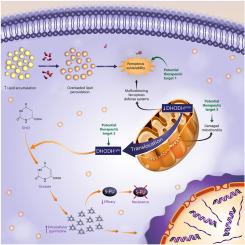当前位置:
X-MOL 学术
›
Redox Biol.
›
论文详情
Our official English website, www.x-mol.net, welcomes your feedback! (Note: you will need to create a separate account there.)
Redistribution of defective mitochondria-mediated dihydroorotate dehydrogenase imparts 5-fluorouracil resistance in colorectal cancer
Redox Biology ( IF 10.7 ) Pub Date : 2024-05-23 , DOI: 10.1016/j.redox.2024.103207 Shuohui Dong 1 , Mingguang Zhang 2 , Zhiqiang Cheng 1 , Xiang Zhang 1 , Weili Liang 1 , Songhan Li 3 , Linchuan Li 4 , Qian Xu 4 , Siyi Song 4 , Zitian Liu 1 , Guangwei Yang 1 , Xiang Zhao 1 , Ze Tao 1 , Shuo Liang 5 , Kexin Wang 1 , Guangyong Zhang 4 , Sanyuan Hu 1
Redox Biology ( IF 10.7 ) Pub Date : 2024-05-23 , DOI: 10.1016/j.redox.2024.103207 Shuohui Dong 1 , Mingguang Zhang 2 , Zhiqiang Cheng 1 , Xiang Zhang 1 , Weili Liang 1 , Songhan Li 3 , Linchuan Li 4 , Qian Xu 4 , Siyi Song 4 , Zitian Liu 1 , Guangwei Yang 1 , Xiang Zhao 1 , Ze Tao 1 , Shuo Liang 5 , Kexin Wang 1 , Guangyong Zhang 4 , Sanyuan Hu 1
Affiliation

|
Although 5-fluorouracil (5-FU) is the primary chemotherapy treatment for colorectal cancer (CRC), its efficacy is limited by drug resistance. Ferroptosis activation is a promising treatment for 5-FU-resistant cancer cells; however, potential therapeutic targets remain elusive. This study investigated ferroptosis vulnerability and dihydroorotate dehydrogenase (DHODH) activity using stable, 5-FU-resistant CRC cell lines and xenograft models. Ferroptosis was characterized by measuring malondialdehyde levels, assessing lipid metabolism and peroxidation, and using mitochondrial imaging and assays. DHODH function is investigated through gene knockdown experiments, tumor behavior assays, mitochondrial import reactions, intramitochondrial localization, enzymatic activity analyses, and metabolomics assessments. Intracellular lipid accumulation and mitochondrial DHODH deficiency led to lipid peroxidation overload, weakening the defense system of 5-FU-resistant CRC cells against ferroptosis. DHODH, primarily located within the inner mitochondrial membrane, played a crucial role in driving intracellular pyrimidine biosynthesis and was redistributed to the cytosol in 5-FU-resistant CRC cells. Cytosolic DHODH, like its mitochondrial counterpart, exhibited dihydroorotate catalytic activity and participated in pyrimidine biosynthesis. This amplified intracellular pyrimidine pools, thereby impeding the efficacy of 5-FU treatment through molecular competition. These findings contribute to the understanding of 5-FU resistance mechanisms and suggest that ferroptosis and DHODH are promising therapeutic targets for patients with CRC exhibiting resistance to 5-FU.
中文翻译:

有缺陷的线粒体介导的二氢乳清酸脱氢酶的重新分布赋予结直肠癌5-氟尿嘧啶耐药性
尽管5-氟尿嘧啶(5-FU)是结直肠癌(CRC)的主要化疗药物,但其疗效受到耐药性的限制。铁死亡激活是治疗 5-FU 耐药癌细胞的一种有前途的治疗方法;然而,潜在的治疗靶点仍然难以捉摸。本研究使用稳定的 5-FU 抗性 CRC 细胞系和异种移植模型研究了铁死亡的脆弱性和二氢乳清酸脱氢酶 (DHODH) 活性。通过测量丙二醛水平、评估脂质代谢和过氧化以及使用线粒体成像和测定来表征铁死亡。通过基因敲除实验、肿瘤行为测定、线粒体输入反应、线粒体内定位、酶活性分析和代谢组学评估来研究 DHODH 功能。细胞内脂质积累和线粒体 DHODH 缺乏导致脂质过氧化超载,削弱了 5-FU 耐药性 CRC 细胞对抗铁死亡的防御系统。 DHODH 主要位于线粒体内膜内,在驱动细胞内嘧啶生物合成中发挥着至关重要的作用,并在 5-FU 耐药性 CRC 细胞中重新分布到细胞质中。胞质 DHODH 与其线粒体对应物一样,表现出二氢乳清酸催化活性并参与嘧啶生物合成。这会放大细胞内嘧啶库,从而通过分子竞争阻碍 5-FU 治疗的功效。这些发现有助于理解 5-FU 耐药机制,并表明铁死亡和 DHODH 是对 5-FU 耐药的 CRC 患者有希望的治疗靶点。
更新日期:2024-05-23
中文翻译:

有缺陷的线粒体介导的二氢乳清酸脱氢酶的重新分布赋予结直肠癌5-氟尿嘧啶耐药性
尽管5-氟尿嘧啶(5-FU)是结直肠癌(CRC)的主要化疗药物,但其疗效受到耐药性的限制。铁死亡激活是治疗 5-FU 耐药癌细胞的一种有前途的治疗方法;然而,潜在的治疗靶点仍然难以捉摸。本研究使用稳定的 5-FU 抗性 CRC 细胞系和异种移植模型研究了铁死亡的脆弱性和二氢乳清酸脱氢酶 (DHODH) 活性。通过测量丙二醛水平、评估脂质代谢和过氧化以及使用线粒体成像和测定来表征铁死亡。通过基因敲除实验、肿瘤行为测定、线粒体输入反应、线粒体内定位、酶活性分析和代谢组学评估来研究 DHODH 功能。细胞内脂质积累和线粒体 DHODH 缺乏导致脂质过氧化超载,削弱了 5-FU 耐药性 CRC 细胞对抗铁死亡的防御系统。 DHODH 主要位于线粒体内膜内,在驱动细胞内嘧啶生物合成中发挥着至关重要的作用,并在 5-FU 耐药性 CRC 细胞中重新分布到细胞质中。胞质 DHODH 与其线粒体对应物一样,表现出二氢乳清酸催化活性并参与嘧啶生物合成。这会放大细胞内嘧啶库,从而通过分子竞争阻碍 5-FU 治疗的功效。这些发现有助于理解 5-FU 耐药机制,并表明铁死亡和 DHODH 是对 5-FU 耐药的 CRC 患者有希望的治疗靶点。
















































 京公网安备 11010802027423号
京公网安备 11010802027423号